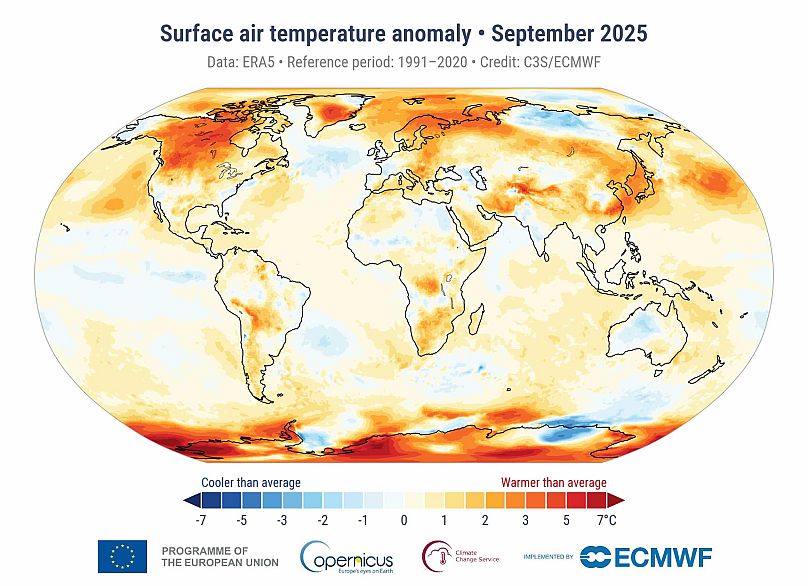September 2025 was the third warmest on record, new data shows.
This summer was an exceptionally hot one. While not the hottest on record, temperatures were only marginally below that figure.
And the warm spell has continued into the beginning of autumn. New data from the Copernicus Climate Change Service shows how September 2025 compared to previous years.
Both land and sea temperatures were consistently high, with Scandinavia reporting particularly notable increases.
Global temperature rise
Copernicus draws on billions of measurements from satellites, ships, aircraft and weather stations around the world. Each month, they publish a report on the state of the climate.
The most recent report shows that this was the third-warmest September globally. The average surface air temperature was 16.11°C, which is 0.66°C above the 1991-2020 average for September.
The warmest September on record was in 2023. September 2025 was only 0.27°C cooler than that month. September 2024 was the second-warmest month, but September 2025 temperatures came very close.
Human-caused climate change increases global temperatures as the burning of fossil fuels releases greenhouse gases that trap heat in the atmosphere. Global warming might also be reducing low-level cloud cover, which causes temperatures to rise.
A warmer sea
As the air warms with climate change, so does the sea. Oceans absorb excess carbon dioxide and heat.
The Copernicus data showed that the ocean temperature was relatively high. September 2025 had a global average sea surface temperature of 20.72°C. This was the third-highest value on record for the month, 0.20°C below the September 2023 average. Above-average sea surface temperature was concentrated in the North Pacific.
In the central and eastern equatorial Pacific, sea surface temperatures were close to or below the 1991-2020 average.
Warmer ocean temperatures can foster sea level rise, fuel extreme weather, and disrupt crucial biological processes.
“A year on, the global temperature context remains much the same, with persistently high land and sea surface temperatures reflecting the continuing influence of greenhouse gas accumulation in the atmosphere,” says Samantha Burgess, Strategic Lead for Climate in the Copernicus Climate Change Service.
How does Europe compare?
In September, the average land temperature in Europe was 15.95°C. This is 1.23°C above the 1991-2020 average for September, making it the fifth highest on record for the month. It was only marginally different from the fourth warmest and sixth warmest Septembers, in 2018 and 2011, respectively.
Eastern Europe and Fennoscandia - a geographic region that includes the Scandinavian peninsula and Finland - continued to see the most pronounced above-average air temperatures. Interestingly, some parts of western Europe saw cooler-than-average temperatures, however these temperatures were typically less than one degree cooler than average.
Regions like the Norwegian sea and the Mediterranean experienced above-average sea surface temperature. Sea ice also suffered. In Europe, below-average concentrations were most pronounced north of Svalbard and the Russian archipelago Franz Josef Land.
Certain parts of Europe were also wetter than usual. It was wetter than average in northwestern and central Europe, Fennoscandia, the eastern Black Sea coast, some parts of Italy, coastal regions of Croatia and eastern Spain. Heavy rainfall caused flooding in certain areas, such as Valencia, Northern Italy, and Croatia's Istria region. Research has shown that climate change makes extreme weather events, like flooding, more frequent and intense.
Some regions were drier than average: most of the Iberian Peninsula, the Norwegian coast, much of peninsular Italy, the Balkans, and parts of Ukraine and Russia saw less rain than usual.












